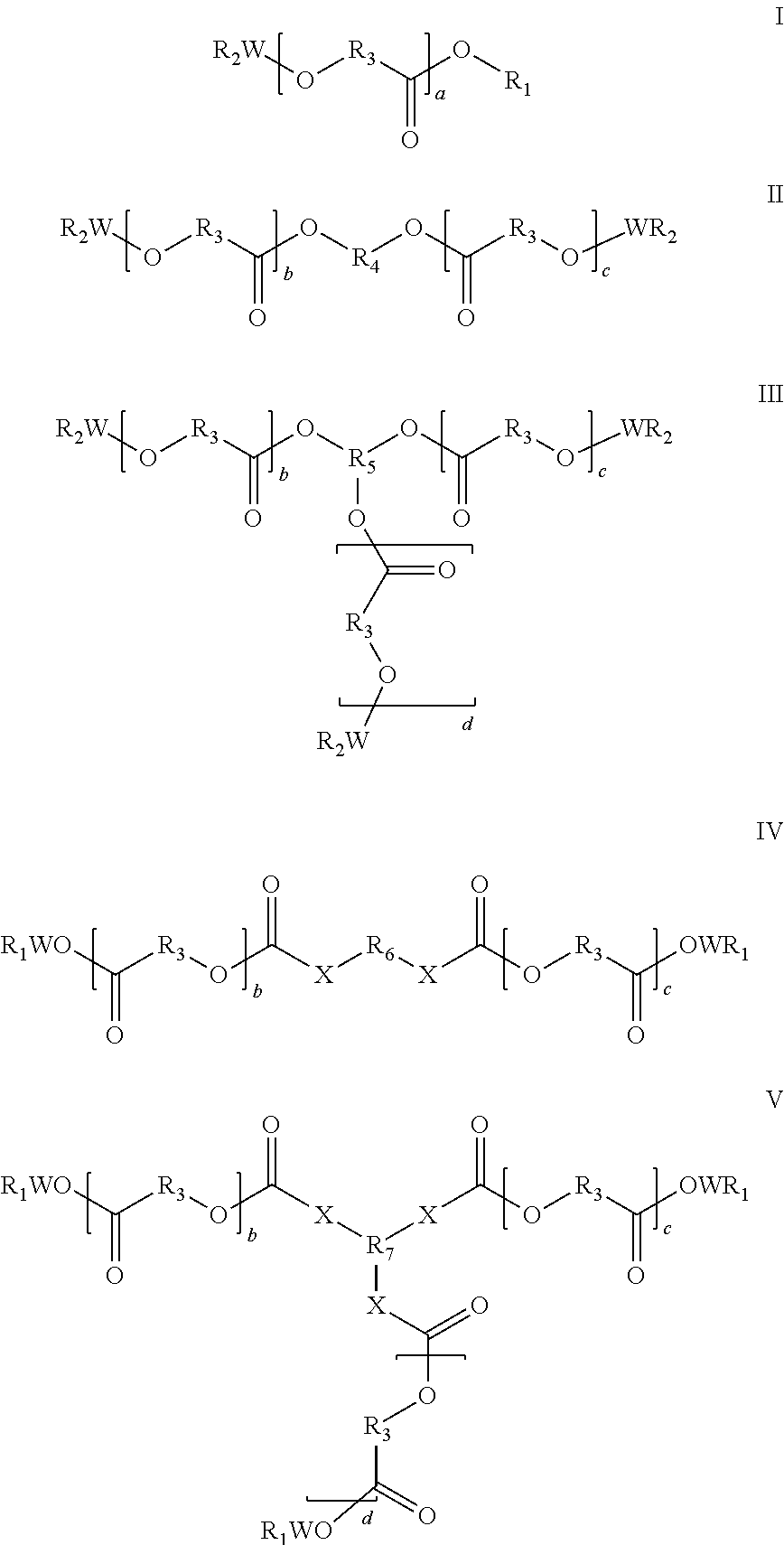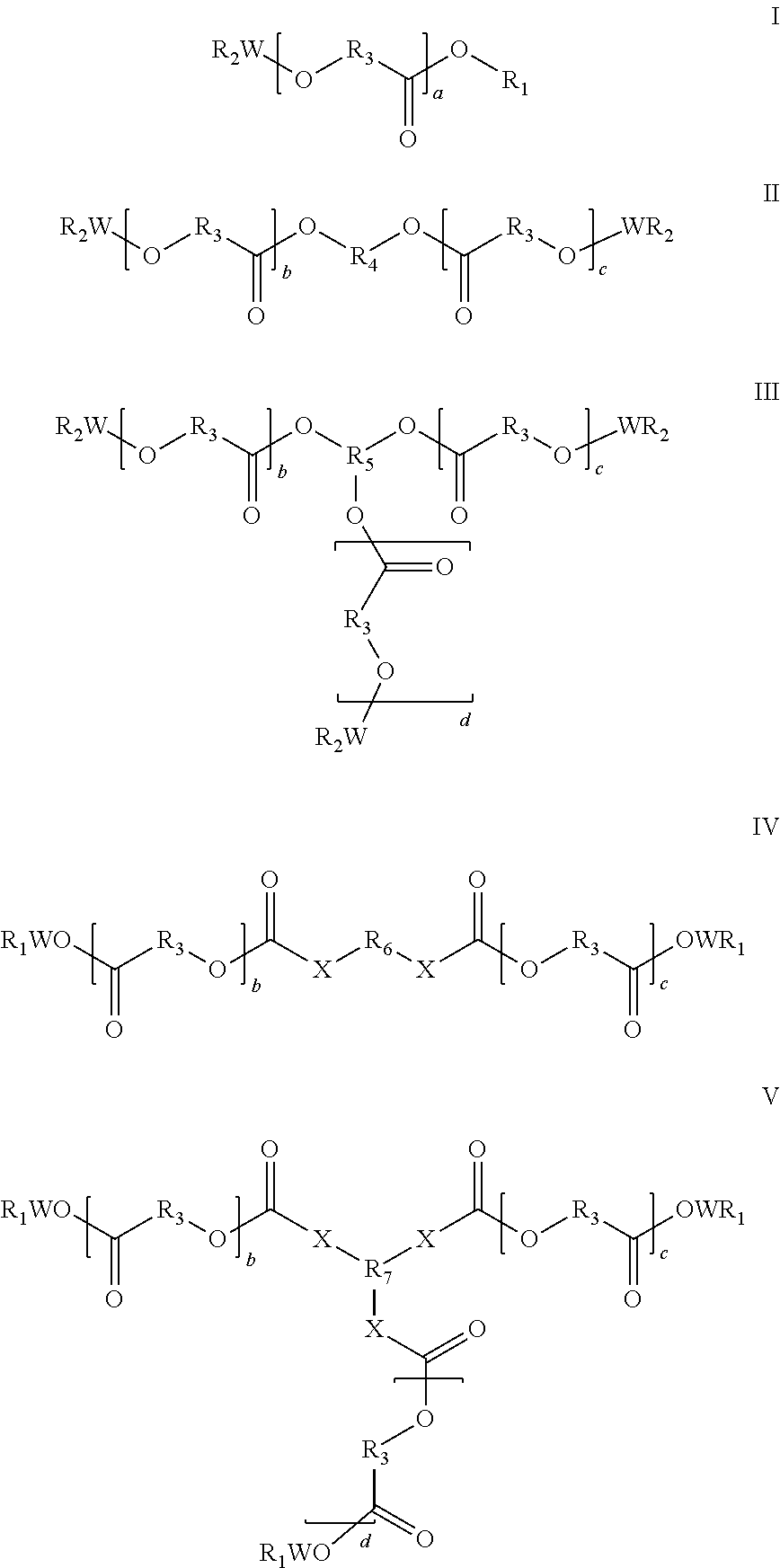Biocompatible oligomer-polymer compositions
a technology of oligomer and polymer, which is applied in the direction of drug compositions, peptides, immunological disorders, etc., can solve problems such as irritation to patients, and achieve the effect of not causing irritation and favorable toxicological properties
- Summary
- Abstract
- Description
- Claims
- Application Information
AI Technical Summary
Benefits of technology
Problems solved by technology
Method used
Image
Examples
example 1
Preparation of Ethyl Lactyllactate
[0274]This procedure was slightly modified from U.S. Pat. No. 2,371,281. 200 milliliters (mL) of anhydrous ethanol, 72 gram (g) of DL-lactide, and a trace amount (approximately 0.01 gram) benzenesulphonic acid were heated under reflux condenser under anhydrous conditions at 75° C. for twenty-four hours. The excess ethanol was removed by distillation and the residue was fractionally distilled under reduced pressure. The first fraction distilled at 40-110° C. at 10 millimeters (mm) mercury (Hg) and was believed to contain mostly ethanol. The second fraction distilled at 110-120° C. at 10 millimeters (mm) mercury (Hg) and was believed to contain ethanol and ethyl lactyllactate. At this time, the distillation was stopped. The reaction mixture remaining in the flask was isolated, tested by gas chromatography-mass spectroscopy (GC-MS), and found to consist mainly of ethyl lactyllactate.
example 2
Preparation of Ethyl(glycoloyloxy)acetate
[0275]This procedure was slightly modified from U.S. Pat. No. 2,371,281. 200 milliliters (mL) of anhydrous ethanol, 72 gram (g) of glycolide, and a trace amount (approximately 0.01 gram) benzenesulphonic acid were heated under reflux condenser under anhydrous conditions at 75° C. for 24 hours. The excess ethanol was removed by distillation. The reaction mixture remaining in the flask was isolated, tested by gas chromatography-mass spectroscopy (GC-MS), and found to consist mainly of ethyl(glycoloyloxy)acetate.
example 3
Preparation of n-Propyl Lactyllactate
[0276]This procedure was slightly modified from U.S. Pat. No. 2,371,281. 200 milliliters (mL) of n-propanol, 72 gram (g) of DL-lactide, and a trace amount (approximately 0.01 gram) benzenesulphonic acid were heated under reflux condenser under anhydrous conditions 75° C. for 24 hours. The reaction mixture remaining in the flask was isolated, tested by gas chromatography-mass spectroscopy (GC-MS), and found to consist mainly of n-propyl lactyllactate.
PUM
| Property | Measurement | Unit |
|---|---|---|
| weight average molecular weight | aaaaa | aaaaa |
| weight average molecular weight | aaaaa | aaaaa |
| polydispersity index | aaaaa | aaaaa |
Abstract
Description
Claims
Application Information
 Login to View More
Login to View More - R&D
- Intellectual Property
- Life Sciences
- Materials
- Tech Scout
- Unparalleled Data Quality
- Higher Quality Content
- 60% Fewer Hallucinations
Browse by: Latest US Patents, China's latest patents, Technical Efficacy Thesaurus, Application Domain, Technology Topic, Popular Technical Reports.
© 2025 PatSnap. All rights reserved.Legal|Privacy policy|Modern Slavery Act Transparency Statement|Sitemap|About US| Contact US: help@patsnap.com



